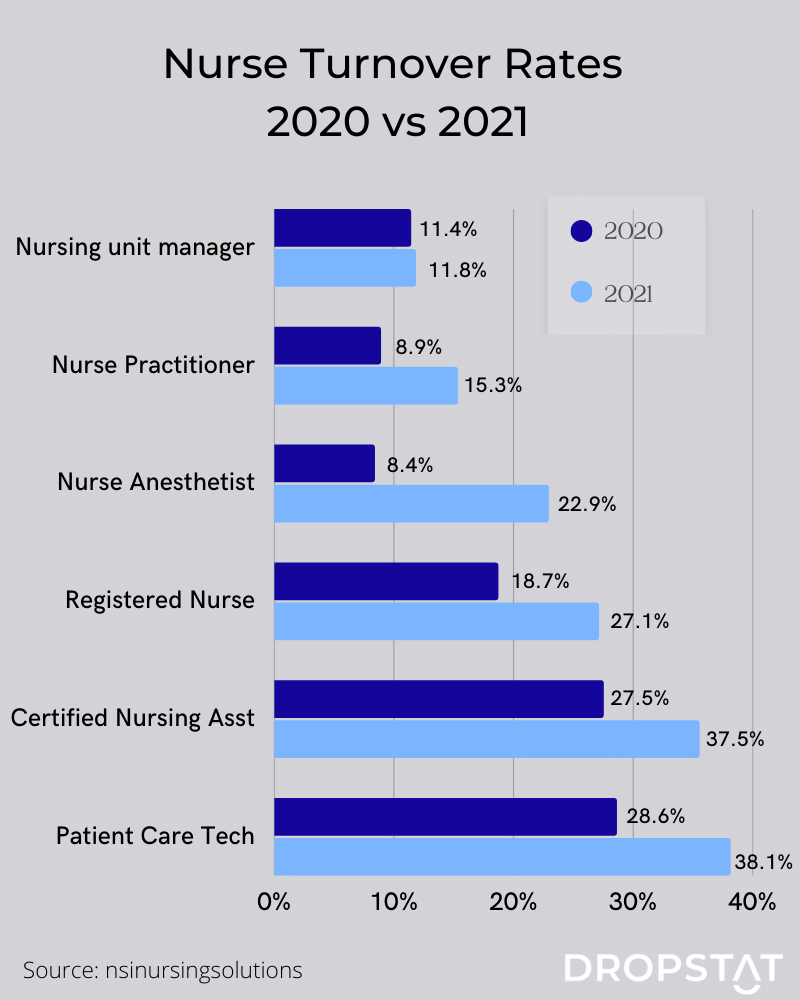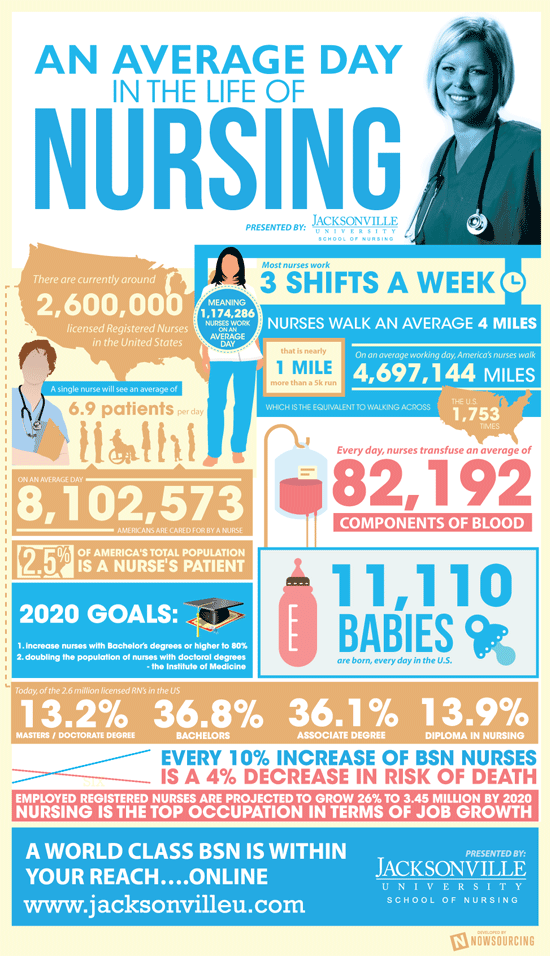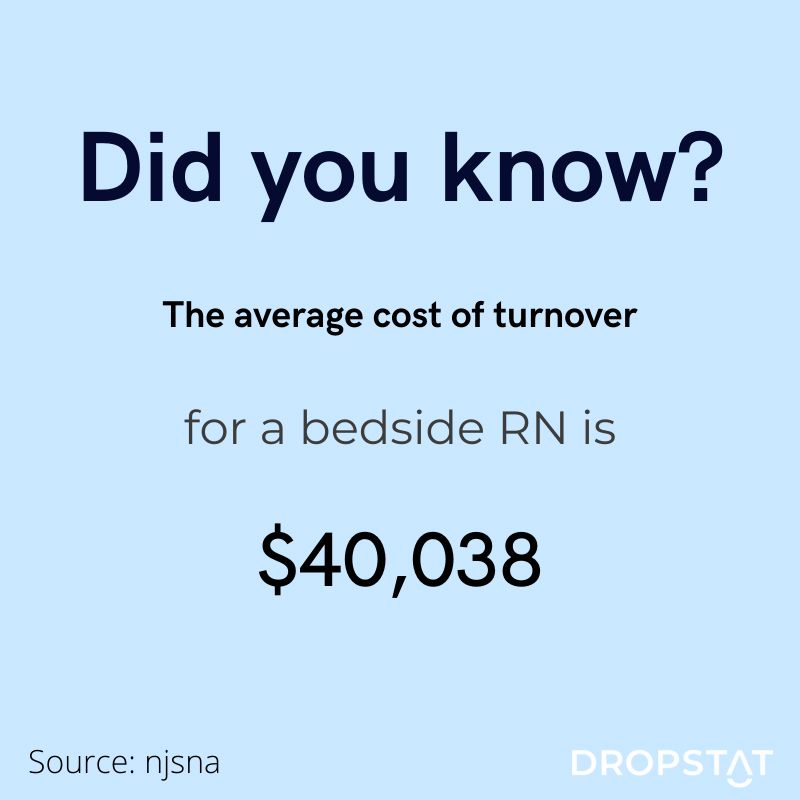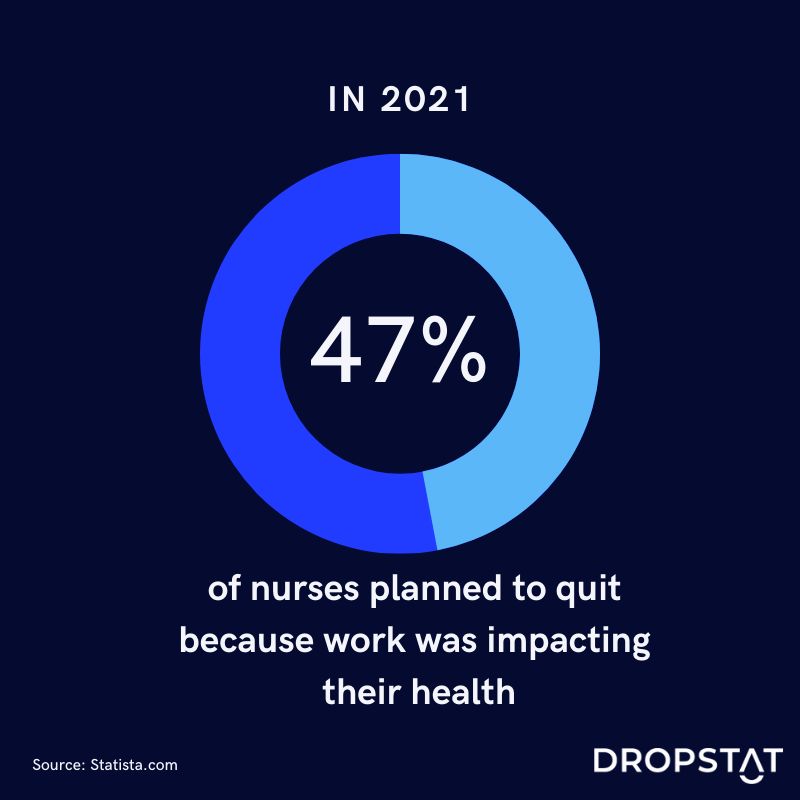Does your nursing department seem to have a revolving door? No matter how many new hires you make, there always seems to be another nurse on their way out, leaving you understaffed and scrambling to fill shifts?
You’re not the only one. The average nurse turnover rate stands at 18.7% nationwide for RNs and ranges as high as 20% for certain nursing specialties. Nurses are leaving their positions in droves, and healthcare facilities are frantically trying to fill the void.
Let’s examine this issue in greater detail: What is nurse turnover? What drives nurses out the door? What is the cost of nurse turnover to healthcare facilities? And most importantly, what can we do to change the turnover trend and encourage nurses to stay?
We’ll address each of these questions to help you retain nurses better, avoid common mistakes, and bring down the costs of nurse turnover for your healthcare facility.
Nurse Turnover: A Definition
Nurse turnover happens when a nurse chooses to leave their current place of employment. They may decide to go for many reasons, but the fact they are leaving contributes to nursing turnover rates.
When nurses leave a healthcare facility, they leave behind a vacant position that needs filling to provide adequate patient care. Their decision to leave sets in motion the recruit-interview-hire cycle for their employer, which is why it is called nurse “turnover.”
Well, Why are Nurses Leaving?
It’s essential to examine the reasons nurses are leaving their jobs. Intelligent healthcare facilities will use this data to help inform and direct their hiring processes, employee culture, and nurse engagement techniques to encourage nurses to stay.
The most common reasons nurses cite when leaving their jobs include:
- Strenuous physical, emotional, and mental labor
- Dealing with chronic understaffing
- Feeling underappreciated
- Long, demanding hours and schedules
- Retirement
- Family reasons, caring for children or other family members
Hard Physical, Mental, and Emotional Labor
The strain of physical, mental, and emotional labor can become overwhelming for both new nurses and veterans in the field.
This strain has become an especially relevant factor during the coronavirus pandemic. Healthcare facilities often operate at maximum capacity levels, with increased safety measures and requirements for both staff and patients. In many cases, nurses work longer and harder hours than usual, and this extra physical, mental, and emotional strain takes its toll. A 2020 study showed over 70% of responding nurses felt exhausted during the Coronavirus pandemic. Furthermore, 47% of nurses surveyed in 2021 planned to quit because their work was negatively affecting their health and well-being.

Dealing with short staffing
One nurse only has two hands. When those two hands, however talented, are expected to fill in for 6,8, or 10 hands, the results are high-stress levels for the nurse, significant decreases in quality of patient care, increased errors, workplace injuries, and constantly falling short of unrealistic managerial expectations. Nurses working at consistently understaffed facilities report this being a significant factor in their decision to leave. Insufficient staffing was the second most common reason nurses cited for wanting to quit.
Feeling Underappreciated
Nursing is an intense, demanding profession, with expectations and pressure often coming from doctors, managers, patients, and patient families all at once. Imagine an average shift for an RN In a mid-sized hospital: In a single shift, the nurse races the clock to provide quality patient care, satisfy manager targets for productivity, follow up on special instructions from doctors, and give support and information to patient families
After all this, their managers may only criticize them for not hitting optimal productivity levels, and colleagues may rebuke them for not helping out more. To top it all off, nurses may be subject to rude or hurtful comments from frustrated patients. The consequences of consistent negative feedback and constantly feeling underappreciated can lead nurses to feel burned out faster and more often and ultimately contribute to rising turnover rates.
Long, Demanding Hours and Schedules
65% of nurses work 12-hour shifts three or four days a week, which is the nurse schedule preferred by most hospitals and facilities providing 24-hour patient care. While nurses may enjoy more days off in their workweek than their 9-5 counterparts, these long hours are physically and mentally exhausting.
Fatigue, especially at the end of a long shift, can increase the likelihood of errors, and sheer exhaustion can slow down nurses’ productivity. Furthermore, the long, intense workdays require nurses to rest adequately and recover afterward. Both the work and recovery periods may ultimately negatively impact nurses’ work-life balance.

Breaking Down the Cost of Nurse Turnover
The cost of turnover for a bedside RN ranges from $28,400 to $51,700, costing healthcare facilities an average of $40,038 per nurse. These numbers translate into staggering losses for hospitals– between $3.6 million and $6.5 million per year. These figures are shocking and make a case for themselves: nurse turnover is simply a huge money drain on healthcare facilities. (NJSNA)
The data shows that once you’ve already invested time and effort into hiring a qualified nurse, it’s much more cost-efficient to work hard to retain that nurse rather than waste money beginning the whole process over again. This cost-benefit analysis justifies offering several thousands of dollars in extra perks and salary raises to increase nurse retention. The alternative, allowing nurse turnover rates to thrive, costs healthcare facilities tens of thousands of dollars.
Besides the monetary cost of nurse turnover, there is also the cost of time, resources, and manpower to start recruiting, hiring, onboarding, and integrating new nurses into a facility, only to repeat the cycle. It’s also important to factor in the impact on staff efficiency and morale to steady nurses to have coworkers who constantly join and leave.
New hires always take time to learn the ropes and integrate into the routine in a new work setting. Consequently, this means a less efficient nursing team in the first weeks and even months after hiring a new nurse. If that new nurse leaves and needs replacing after only a year, the nursing team will be working less efficiently for nearly 6 months out of the year!
Furthermore, coping with a “revolving door” of coworkers takes an emotional toll on nurses, who must constantly adjust and readjust to a new social dynamic at work. This distracting social aspect can have devastating consequences for nurses who need to be at peak alertness and efficiency to provide critical care to patients. In addition, constantly shaking up the social dynamic of the nursing staff makes it difficult for nurses to form strong work relationships, which are vital in an environment that relies heavily on teamwork and cooperation.
In all, the cost of nurse turnover is both prohibitively expensive and an unnecessary drain on facilities’ resources. High turnover rates cost healthcare facilities millions of dollars and hundreds of wasted hours in manpower, efficiency, and decreased quality of patient care and safety. It’s high time for healthcare facilities to start focusing on nurse retention.

How to Address Nurse Turnover in the Workplace
An overwhelming 89.1% of organizations recognize nurse retention as a “key strategic imperative,” however, just over a third have a formal retention strategy.
Here are some key points to include in your organization’s nurse retention strategy:
- Hire purposefully to meet your facility’s needs
- Provide ample lead time for nurses to pick up extra shifts
- Emphasize onboarding and training
- Recognize excellent work consistently and meaningfully
- Encourage career development and continuing education
Hire Purposefully
Assess your facility’s real hiring needs before putting out a job listing to ensure you’re looking for suitable candidates to fill the proper role. Suppose your facility is consistently scrambling to fill LPN shifts with bonuses, overtime, and agency staff while you’re hiring for a full-time RN position. In that case, that is indicative of a disconnect between your staffing needs and your management. Such disconnect sets nurses up for failure as they enter a team already missing the support staff they need to do their job correctly.
Assess your staffing needs, hire for the right role, and fill that role with a qualified candidate to set up your nursing team for success and prevent churn.
Emphasize Onboarding and Training
Give new hires the training and time they need to learn the ropes in a new work setting. Every facility has different team dynamics and protocols, and it can take at least a couple of months for new nurses to get acclimated. Provide the training and support they need during the first critical weeks and months and have realistic productivity expectations to give them a solid foundation to succeed. Few things will send nurses packing faster than feeling unsupported and overwhelmed in a new work setting.
Provide Ample Lead Time to Pick Up Extra Shifts
Nurses are also people with personal lives and schedules- and they value the ability to plan their schedules in advance. Dropstat’s research shows that nurses overwhelmingly value predictability and control of their schedules more than the perks of bonuses and overtime as an incentive to pick up extra shifts.
Allow your nurses the peace of mind to plan their lives ahead of time and pick up as many or as few extra shifts as they choose in advance. Increased lead time will help cut down on the headaches and stress of filling extra shifts at the last minute and reserve “crisis mode” for when there is a true emergency. Increased predictability and schedule control will lower stress levels and lend themselves to greater nursing job satisfaction and retention.

Recognize Excellent Work Consistently
A little bit of appreciation and recognition goes a long way in boosting staff morale. Ensure your facility’s work culture notices, appreciates, and recognizes excellent work. Gratitude can be as simple as a “nurse of the month” bulletin board, shout-outs at staff meetings, or small gift cards to the nearby Starbucks. Showing your staff that you notice and appreciate excellence raises the bar and means that you’ll get more of it. Nurses who feel that their contributions are meaningful and recognized have greater job satisfaction and are much less likely to turnover.
Encourage Career Development and Continuing Education
Investing in your staff’s continuing education and career development shows them that you care about their professional development on a personal level. Organize refresher courses, have a budget for CE, and encourage nurses to further their knowledge and careers to become better at what they do and develop their professional skills. Nurses who feel they are growing versus stagnating in their careers have much higher job satisfaction and retention rates.
These are just a few things you can incorporate into your nurse retention strategy to make your nurses feel supported, appreciated, and satisfied with their career direction. Focusing on nurse retention will help your facility avoid the many pitfalls of nurse turnover.
Managing Nurse Turnover with Dropstat Analytics
Dropstat empowers healthcare facilities with the data and insights to manage nurse turnover before it happens. Dropstat Analytics utilizes powerful APIs and machine learning to help healthcare facilities discover, analyze, and address risk factors for turnover among their nursing staff. This technology specializes in pinpointing the weakest points in your current staffing plan and flags harmful patterns so you can stop them before they escalate. Hindsight is 20/20, but foresight is worth a lot more.
Dropstat helps facilities effortlessly fill shifts with existing staff first while filling in gap shifts with cost-effective temporary solutions. AI software identifies recurring staffing needs and suggests cost-effective long-term staffing solutions to combat short staffing and unnecessary overspending and achieve safe staffing.
Ultimately, Dropstat enables healthcare facilities to support their nursing staff with the colleagues and manpower they need at each shift. Safely staffing every shift reduces the demand on nurses stretched too thin and increases nurse job satisfaction, which helps slow the nurse turnover rate.
Why Should Healthcare Facilities Address Nurse Turnover: The Bottom Line
Nurse turnover carries a hefty price tag for healthcare facilities in money, time, energy, manpower, and resources. The sooner healthcare facilities identify and address the root causes of nurse turnover, the sooner they can improve nurse retention, thereby driving down staffing costs for their facilities.






